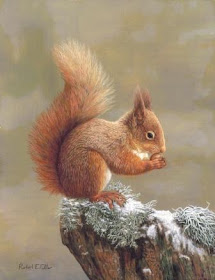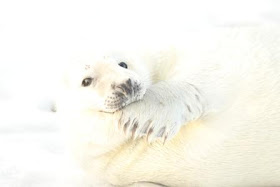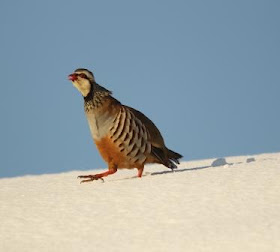
Shortly before Christmas I drove to Donna Nook in Lincolnshire to see the seals. Grey seals come here each winter in their 1000s to pup and to breed.

Maternal care in seals is very short-lived. It lasts just two to three weeks. The pups are weaned after an average of 18 days.

Seal milk is very rich though. It is made up of 52pc fat and 11pc protein - cows milk has just 3pc fat, 3pc protein and 88pc water!
The pups put on weight very quickly - an average of 1.7kg a day. By the end of the suckling period they have trebled their birth weight. The mother, in contrast, loses weight, about 3.8kg a day.

This pup is just three days old. It's skin looks loose and wrinkly but it will soon grow into it.
This pup is roughly three weeks old, already weaned and ready to make its first journey out to sea. Pups stay on the beach for at least a week after weaning. It's fun to watch them get more alert and playful.

Because they are no longer feeding, they rely on the blubber they have accumulated while feeding from their mothers. But they do lose about 1.4kg a day for the first three days and then 1kg a day after that.

I spent quite a long time photographing this pup. It was the cleanest on the beach and was lying on a large patch of ice with gave me a clean background.

I could have been in the arctic.

Females are ready to mate just three weeks after pupping.

Males lies close to the females in order to defend her from other males.

I saw this female taking a well-earned break in a shallow pool.

The male seals are like heavyweight champions. This male bore the bloody scars of a recent battle.

A grey seal's long whiskers help them to locate food in poor visibility.

Grey seals also moult whilst they are on shore. This male was looking particularly patchy.
 Apparently the RSPB is expecting more unusual 'countryside' birds like this brambling to feature this year because the cold weather has tempted more of these shier species to try the feeders in suburban gardens.
Apparently the RSPB is expecting more unusual 'countryside' birds like this brambling to feature this year because the cold weather has tempted more of these shier species to try the feeders in suburban gardens.




 Today Radio York visited, earlier this week BBC Radio Humberside were here and the York Evening Press, Scarborough Evening News and Hull Daily Mail have all featured the story.
Today Radio York visited, earlier this week BBC Radio Humberside were here and the York Evening Press, Scarborough Evening News and Hull Daily Mail have all featured the story.


 This was one of the saddest sights of all: a pair lying dead at the bottom of one of the boxes, the male with its wing lying protectively over the female.
This was one of the saddest sights of all: a pair lying dead at the bottom of one of the boxes, the male with its wing lying protectively over the female. It's absolutely tragic. Some of the carcases I collected were those of the models I have used for paintings, like these.
It's absolutely tragic. Some of the carcases I collected were those of the models I have used for paintings, like these.  It feels like I've lost some of my oldest friends.
It feels like I've lost some of my oldest friends. If the cold weather that we had over November and December returns, it could take 10 - 15 years for the population to recover.
If the cold weather that we had over November and December returns, it could take 10 - 15 years for the population to recover.  For more on the plight of these beautiful birds click
For more on the plight of these beautiful birds click 

 Maternal care in seals is very short-lived. It lasts just two to three weeks. The pups are weaned after an average of 18 days.
Maternal care in seals is very short-lived. It lasts just two to three weeks. The pups are weaned after an average of 18 days. 




 I could have been in the arctic.
I could have been in the arctic.


 In some photographs I deliberately over-exposed the pictures to soften the edges and to make the eyes and muzzles of the seal pups stand out all the more.
In some photographs I deliberately over-exposed the pictures to soften the edges and to make the eyes and muzzles of the seal pups stand out all the more.
 Males lies close to the females in order to defend her from other males.
Males lies close to the females in order to defend her from other males. 





 There was 18 inches of snow on top of the ant hill and it soon gave up.
There was 18 inches of snow on top of the ant hill and it soon gave up.








 Woodcock is one of Europe's most elusive birds and although readily spotted when flushed by beaters on shoot days, it is rarely seen naturally foraging on the ground.
Woodcock is one of Europe's most elusive birds and although readily spotted when flushed by beaters on shoot days, it is rarely seen naturally foraging on the ground. But since the ground has been frozen solid I've been able to watch this enigmatic bird at close quarters.
But since the ground has been frozen solid I've been able to watch this enigmatic bird at close quarters.